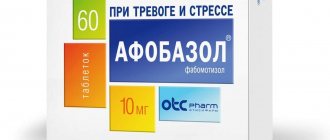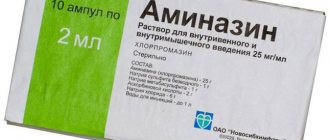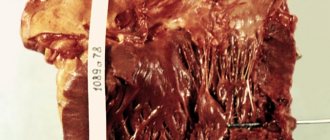You can determine whether you have panic attacks yourself. Created by American psychologist Wayne Caton, the panic attack questionnaire has high sensitivity (81%) and specificity (99%). To get accurate results, you must read the questions carefully and answer them “yes” or “no.” So, take paper, pen or pencil and let's go.
Section “A”. Identifying warning signs of a panic attack
- Over the past 4 months, have you experienced a sudden feeling of anxiety, fear, or horror?
- Have you felt anything like this before?
- Do these attacks or part of them appear unexpectedly, regardless of the specific situation that is unpleasant or uncomfortable for you?
- Are you afraid of having another anxiety attack?
- Are you afraid of the negative consequences of panic, death?
Section “B”. Identifying Physical Signs of a Panic Attack
During an anxiety attack, have you experienced symptoms such as:
- Increased breathing, its superficial nature?
- Uncomfortable, painful sensations in the left side of the chest?
- Rapid heartbeat, increased heart rate, irregular heartbeat, or the feeling that your “heart has stopped”?
- Shortness of breath, lack of oxygen in the lungs?
- Increased sweating?
- An unexpected surge of cold or hot waves?
- Unpleasant sensations in the stomach, the urge to feel sick, diarrhea, or nausea or diarrhea itself?
- Unstable state, dizziness, fog, feeling faint?
- Tingling, numbness in your arms, legs or throughout your body?
- Trembling, “twitching” of the arms or legs, a feeling that the skin on the face, neck, or back of the head is “tightening”?
Let's sum it up
If you answered “no” to the first question in section “A,” then what follows may not be a panic attack, but a neurological or therapeutic disease.
If an affirmative answer “yes” is received to at least one question from section “A” and four questions from section “B”, then we can judge panic disorder.
It is worth noting that independently identified and interpreted results cannot serve as a diagnosis. A panic attack can only be diagnosed by professional tests conducted by a certified specialist.
Test to determine the degree of anxiety
Answer the test questions based on your feelings from the last month. By choosing one of the four answer options, award yourself points.
A. I am in a state of tension, I feel unusual:
- Constantly – 3 points
- Often – 2 points
- Sometimes, sometimes – 1 point
B. I'm afraid - it seems to me that something terrible is about to happen:
- Yes, that’s right, I feel very afraid – 3 points
- Yes, it exists, but the fear is small, non-lethal - 2 points
- Sometimes I feel afraid, but it doesn’t bother me much – 1 point
- Didn’t experience it at all – 0 points
Q. I think about problems and worry:
- Yes, all the time – 3 points
- To a greater extent than about other things – 2 points
- As it comes in, infrequently – 1 point
- Rarely, sometimes – 0 points
G. I easily relax by simply sitting down:
- This is far from true - 3 points
- Occasionally, sometimes – 2 points
- This may be true - 1 point
- Yes, for sure – 0 points
D. I am familiar with the feeling of internal trembling, the feeling of “goosebumps”:
- Yes, very often – 3 points
- Happens often – 2 points
- Sometimes – 1 point
- I don’t know what it is – 0 points
E. I can’t sit in one place, I need to be in constant motion:
- Yes, that's right – 3 points
- Perhaps this is so - 2 points
- Depends on the situation – 1 point
- No, this is not about me – 0 points
G. I feel panicky feelings:
- Very often – 3 points
- Often happens – 2 points
- Sometimes – 1 point
- Never experienced it – 0 points
Features of the test
You can take a PA symptom test online. If you answered yes to the first question, then contact a psychologist.
Panic disorder test questions help determine your condition:
- Have you had any feelings of fear, anxiety, or horror over the past 3-4 months?
- If yes, please clarify, is this your first time encountering such sensations?
- Do you feel anxious about having another attack?
- Were the manifestations unexpected or related to a specific uncomfortable situation?
- Has the fear of death appeared?
Results on a panic attack test are not a diagnosis. Only the thoughtful approach of a certified specialist will establish the presence of the disease.
Clinically significant panic attack Not observed
You have no reason to worry, there are no psychic attacks.
Online consultation with a psychotherapist Test results:
Having a clinically significant panic attack (disorder)
You have been diagnosed with severe panic disorder (attack). To solve this problem, psychological help is needed
Make an online appointment with a psychotherapist Test results:
Manifestations of pathology
Often, panic attacks are mistakenly treated as diseases of “vegetative crisis”, “neurocircular dystonia” or “vegetative-vascular dystonia”. The reason for this is an incorrect diagnosis and ignoring consultation with a psychiatrist. In psychology, such manifestations are associated with the periodic appearance of an acute feeling of fear, at a conscious or subconscious level.
The clinical development of the attack is similar to panic disorder. However, the latter is a complex disease in which panic attacks occur constantly. The patient understands what is happening and himself suggests when to expect a new attack. This reaction occurs in healthy people in connection with serious emotional trauma or acute irritant. Panic can manifest itself as a consequence of the following pathologies:
- diseases of the endocrine system;
- organic disorders of the heart and blood vessels;
- depression;
- phobias.
The patient is visited by a feeling of fear, anxiety and a desire to panic grows. These emotions are among the leading ones in this reaction. This condition is characterized by pronounced vegetative symptoms:
- cold sweat, increased sweating;
- lack of air, shortness of breath, sometimes bordering on suffocation;
- pain syndrome in the chest area;
- discomfort in the intestines, urge to vomit;
- dizziness, fainting;
- fear of death;
- pressure surges, hearing and vision disorders;
- heartbeat disturbance;
- involuntary urination.
TEST TO DETECT PANIC ATTACKS (Katon WJ Patient Health Questionnaire (PHQ) Panic Screening Questions) A. Anxiety attacks. 1. Have you had attacks of sudden anxiety, fear or horror during the last 4 months? 2. Have you ever had similar attacks before? 3. Do some of these attacks occur unexpectedly, without connection to a specific situation where you would feel anxiety or discomfort? 4. Do you have a fear of an attack or its consequences? B. During your last attack (attack), you experienced: 1) shallow, rapid breathing 2) palpitations, pulsation, interruptions in the work of the heart or a feeling of its stopping 3) pain or discomfort in the left half of the chest 4) sweating 6) a feeling of lack air, shortness of breath 6. heat or cold waves 7. nausea, stomach discomfort, diarrhea or urge 8.) dizziness, unsteadiness, brain fog or lightheadedness 9. tingling or numbness sensations in the body or limbs 10. body tremors , limbs, twitching or tightening of the body (limbs) 11) fear of death or irreversible consequences of an attack If you answered “yes” to at least one question in section A and to any four questions in section B, you have panic attacks and you need to see a psychotherapist or a psychiatrist. Since the “triggering” factor of a panic attack is most often anxiety, timely identification and treatment of an anxiety disorder is very important. TEST TO ASSESS THE LEVEL OF ANXIETY Instructions. Read each statement carefully and choose an answer based on how you have been feeling over the past month. 1. I feel tense and uneasy: a) all the time; b) often; c) from time to time, sometimes; d) I don’t feel it at all 2. I feel fear, it seems as if something terrible is about to happen a) yes, this is so, and the fear is very strong; b) yes, this is true, but the fear is not very strong; c) sometimes I do, but it doesn’t bother me; d) I don’t feel it at all 3. Restless thoughts are spinning in my head a) constantly; b) most of the time; c) from time to time; d) only sometimes 4. I can easily sit down and relax a) this is not true at all; b) only rarely is this true; c) perhaps this is so; d) yes, that's true 5. I experience internal tension or trembling a) very often; b) often; c) sometimes; d) I don’t feel it at all 6. It’s hard for me to sit still, as if I constantly need to move a) yes, that’s true; b) perhaps this is so; c) only to some extent this is true; d) this is not true at all 7. I have a feeling of panic a) very often; b) quite often; c) sometimes; d) does not happen Now calculate the result: answer option “a” corresponds to 3 points, “b” - 2, “c” - 1, “d” - 0 points. Sum up your points. If the sum of points is from 0 to 3, the level of anxiety is within normal limits; from 4 to 7 – a slight increase in the level of anxiety, we advise you to consult a psychologist; from 8 to 10 – moderate anxiety, it is best to consult a psychotherapist to correct the condition; from 11 to 15 – severe anxiety, we recommend that you consult a psychotherapist and undergo a course of treatment; 16 points or more – a sharp increase in the level of anxiety; qualified treatment by a psychiatrist or psychotherapist is required.
Panic attack (synonyms: vegetative crisis, sympathoadrenal crisis) is an acute attack of fear that arises due to reasons conscious or unconscious to a person, accompanied by vivid vegetative symptoms characteristic of a moment of strong fear of something.
A panic attack should not be confused with a panic disorder - a psychopathological condition in which the patient is regularly fully aware of his pathological condition and expects the next attack of a panic attack.
Panic can spontaneously arise in a mentally healthy person, as a result of exposure to an acute psychogenic stimulus or emotional trauma, and can also be an additional clinical sign of other mental disorders: phobias, organic diseases of the cardiovascular system, depressive disorders, endocrine diseases.
In order to distinguish the protective reflex reactions of the nervous system, in the form of manifestations of fear, in healthy people from mental abnormalities, panic attack tests specially designed for these purposes are used.
Panic attack test, pathology detection and questionnaire
The pathological condition associated with panic disorders provokes the development of problems with general well-being, disturbances in cardiac activity and even the gastrointestinal tract. Often, making a correct diagnosis takes a long time. A test for panic attacks helps not only to correctly diagnose, but also to begin adequate treatment.
Manifestations of pathology
Often, panic attacks are mistakenly treated as diseases of “vegetative crisis”, “neurocircular dystonia” or “vegetative-vascular dystonia”. The reason for this is an incorrect diagnosis and ignoring consultation with a psychiatrist. In psychology, such manifestations are associated with the periodic appearance of an acute feeling of fear, at a conscious or subconscious level.
The clinical development of the attack is similar to panic disorder. However, the latter is a complex disease in which panic attacks occur constantly.
The patient understands what is happening and himself suggests when to expect a new attack. This reaction occurs in healthy people in connection with serious emotional trauma or acute irritant.
Panic can manifest itself as a consequence of the following pathologies:
Useful article? Don't miss new ones! Enter your email and receive new articles by email
Source: https://dnevnyk-uspeha.com/testyi/panicheskaja-ataka-test.html
Symptoms of a panic attack
A strong feeling of fear, a tense feeling of anxiety, and a desire to panic are the main emotional experiences at the time of a panic attack, which are combined with at least four of the following vegetative symptoms that fully reflect the manifestations of fear:
- Tachycardia, often against the background of cardiac arrhythmia.
- Increased sweating with a persistent feeling of “cold sweat.”
- Sensations of shaking of internal organs, tremor of skeletal muscles, especially sensitive in the area of the fingers and knees.
- Acute air deficiency, rapid breathing, usually inspiratory dyspnea. Attacks of acute suffocation are common.
- Persistent pain in the center and left area of the sternum.
- Discomfort in the intestinal area, frequent voluntary opening of the external anal sphincter, nausea.
- Dizziness, feeling of lightness in the head.
- Fainting or pre-fainting state.
- A persistent feeling of loss of reason amid fear of doing the wrong thing.
- Fear of death.
- A chaotic cycle of diverse, unrelated, very obsessive thoughts.
- Frequent, sometimes involuntary urination, “lump in the throat.”
- Possible problems with vision and hearing, high or low blood pressure.
As mentioned above, feelings of anxiety, fear and panic are the main symptoms of this mental disorder. It should be noted that each of these phenomena can manifest separately from each other, characterizing the severity of mental suffering, sequentially - exactly in the sequence as they are listed, or - in a mixed state, as the most severe manifestation of an attack.
A feature of the anxiety state is persistent nervous tension, in which vegetative symptoms may appear weakly or not appear at all. This version of a psychic attack is often called “panic without panic.”
The frequency of panic attacks can vary greatly - from one episode per month to several within an hour. The duration of one attack also varies quite a lot, but on average it is about 15-20 minutes.
Panic attacks are usually classified as spontaneously occurring disorders, but a more detailed study of the patient’s history and interviewing sometimes reveals some situational dependence on the occurrence of the next attack.
The first manifestations of panic attacks force a person to turn to a sufficient number of general specialists, in search of serious diseases of the cardiovascular, nervous, digestive systems, and so on. The absence of any pathologies begins to convince the patient that he has some very rare, unique disease and, most likely, fatal. This turn of events often leads to the development of depression, often of a hypochondriacal nature, and further increases the frequency of panic attacks, transforming the deviation into a panic disorder.
Diagnostics
To draw up a complete and clear clinical picture of the pathological phenomenon, it is necessary:
- analyze the symptoms that accompany the paroxysm;
- identify, if any, the symptoms preceding the paroxysm and the symptoms that arose as a result of the attack;
- determine the time boundaries of the attack;
- analyze factors and situations that could provoke an attack;
- analyze the pathological phenomenon in the sleep-wake cycle.
When diagnosing panic disorder, experts use clear criteria.
A panic attack is said to occur if the patient has the following symptoms:
- hypertrophied fear, reaching the point of horror and accompanied by a feeling of the inevitability of death;
- feeling of internal psycho-emotional tension;
- the presence of four or more panic-associated symptoms.
List of panic-associated symptoms:
- tachycardia, rapid pulse;
- increased sweating;
- tremor throughout the body, chills;
- feeling as if you are suffocating, shortness of breath;
- a feeling of tightness and discomfort in the left chest;
- nausea, vomiting and abdominal discomfort;
- foggy consciousness, dizziness, lightheadedness;
- disorientation in space, depersonalization;
- fear of committing an uncontrollable act, fear of losing one’s mind;
- fear of death;
- numbness in the extremities;
- sensation of waves of cold and heat passing through the body.
The key criterion for a panic attack is hypertrophied anxiety.
The degree of its severity can vary from a feeling of internal discomfort to a clearly manifested affect of panic.
In the first variant, a panic attack is not burdened with an emotional component and is manifested mainly by vegetative symptoms. Such attacks occur most often in neurological practice.
The study revealed that as the disease worsens, the severity of fear during attacks decreases.
The number of panic-associated symptoms may vary among patients. Sometimes there are cases where full-fledged attacks are accompanied by only 2-3 panic-associated symptoms. These attacks are called "minor panic attacks."
But if the clinical picture shows 5-6 symptoms that are not characteristic of panic disorder, then such a diagnosis must be excluded. To simplify the diagnosis of a panic attack, there is a test that allows you to quickly determine this condition. The test is based on an index of panic attack typicality.
The key difference between panic disorder and other pathological conditions is the absence of a prodromal period. The attacks appear suddenly and develop to their peak within 10 minutes. After an attack, weakness and inner emptiness are felt throughout the body. Individual patients o.
However, confusion and sleep in the post-attack period are not characteristic of panic disorder.
When diagnosing this type of disorder, it is necessary to take into account the duration of the panic attack. On average it lasts from 15 minutes to half an hour. But there have also been cases of longer lasting panic attacks. During the tests, a direct relationship was established between the number of atypical symptoms accompanying the attack and its duration.
To obtain a complete clinical picture of panic attacks, it is necessary to analyze the causes of their occurrence. In most patients, panic attacks begin spontaneously, however, with the help of a detailed conversation, it is possible to determine not only spontaneous insurmountable worries, but also situational ones, which are a reaction to some “dangerous” circumstances.
Such circumstances may include being in a confined space, traveling on a trolleybus, speaking in front of a large audience, etc.
Panic attacks occur during wakefulness, mainly during the day or evening, but there are patients with attacks that appear not only during the day, but also at night. Very rarely, patients with predominantly nocturnal panic attacks are observed.
What does a doctor need to know?
According to the International Directory of Diseases, panic disorder is diagnosed if the following criteria are present:
- Repeated panic attacks.
- Panic attacks last for at least a month and are accompanied by the following symptoms:
- fear of repeating a panic attack;
- fear of worsening the attack, loss of reason and self-control;
- significant behavioral change caused by attacks.
- The attacks are not the result of exposure to any substances or symptoms of physical illness.
Self-diagnosis
You can detect panic disorder yourself.
A special questionnaire for identifying panic attacks, developed by American psychologist Wayne Caton, can help with this. The test has been tested and has high validity and reliability
By reading the test questions and answering them “yes” or “no,” you can get the most reliable result, typical for self-diagnosis.
A doctor's view of a panic attack and a panic attack test.
Panic attack
often not considered from the perspective of the disease. Under certain conditions, almost anyone can experience a panic attack. In the presence of severe emotional stress, manifestations at the body level may occur that indicate panic attacks. However, sometimes panic begins to progress and is diagnosed in
1.9-3.6% of the population. With some advantage among women.
During a panic attack, a person feels intense fear, which is combined with physical manifestations. I mentioned the symptoms of panic attacks earlier, so I won’t dwell on them.
When diagnosed by a doctor, an attack can be classified as a vegetative crisis or vegetative-vascular dystonia. However, panic attack is currently a globally recognized term, included in the classification of diseases.
In order to classify your attack according to a panic attack, I offer you a small test.
The Panic Attack Test was compiled by Wayne J. Katon. Full name: Patient Health Questionnaire (PHQ) Panic Screening Questions.
1. Question about the presence of anxiety attacks. (answer “Yes”, “No”)
a) have you experienced attacks of sudden anxiety, fear or horror during the last 4 months?
(if the answer is “yes”, continue answering the questions).
b) have you ever had similar attacks before?
c) do some of these attacks occur unexpectedly, without connection with a specific situation where you would feel anxiety or discomfort?
d) are you afraid of an attack or its consequences?
2. During your last attack (attack), you experienced:
(answer “Yes”, “No”)
a) shallow, rapid breathing
b) palpitations, pulsation, interruptions in heart function or a feeling of cardiac arrest
c) pain or discomfort in the left side of the chest
d) sweating
e) feeling of lack of air, shortness of breath
f) waves of heat or cold
g) nausea, stomach discomfort, diarrhea or cravings
h) dizziness, unsteadiness, brain fog or lightheadedness
i) tingling or numbness sensations in the body or limbs
j) trembling in the body, limbs, twitching or tightening of the body (limbs)
k) fear of death or irreversible consequences of an attack?
If you answer the questions in paragraph 1 ad “Yes” and any 4 questions in paragraph 2 ak “Yes”, you can assume that you are experiencing panic attacks.
You can determine whether you have panic attacks yourself. Created by American psychologist Wayne Caton, the panic attack questionnaire has high sensitivity (81%) and specificity (99%). To get accurate results, you must read the questions carefully and answer them “yes” or “no.” So, take paper, pen or pencil and let's go.
Section “A”. Identifying warning signs of a panic attack
- Over the past 4 months, have you experienced a sudden feeling of anxiety, fear, or horror?
- Have you felt anything like this before?
- Do these attacks or part of them appear unexpectedly, regardless of the specific situation that is unpleasant or uncomfortable for you?
- Are you afraid of having another anxiety attack?
- Are you afraid of the negative consequences of panic, death?
Section “B”. Identifying Physical Signs of a Panic Attack
During an anxiety attack, have you experienced symptoms such as:
- Increased breathing, its superficial nature?
- Uncomfortable, painful sensations in the left side of the chest?
- Rapid heartbeat, increased heart rate, irregular heartbeat, or the feeling that your “heart has stopped”?
- Shortness of breath, lack of oxygen in the lungs?
- Increased sweating?
- An unexpected surge of cold or hot waves?
- Unpleasant sensations in the stomach, the urge to feel sick, diarrhea, or nausea or diarrhea itself?
- Unstable state, dizziness, fog, feeling faint?
- Tingling, numbness in your arms, legs or throughout your body?
- Trembling, “twitching” of the arms or legs, a feeling that the skin on the face, neck, or back of the head is “tightening”?
Let's sum it up
If you answered “no” to the first question in section “A,” then what follows may not be a panic attack, but a neurological or therapeutic disease.
If an affirmative answer “yes” is received to at least one question from section “A” and four questions from section “B”, then we can judge panic disorder.
It is worth noting that independently identified and interpreted results cannot serve as a diagnosis. A panic attack can only be diagnosed by professional tests conducted by a certified specialist.
Testing for panic attacks
If there is a suspicion of panic attacks or panic disorder, it is permissible to conduct several basic tests that allow you to lean towards one opinion or another and decide to visit a psychotherapist.
As a rule, all panic attack tests consist of two main blocks. The first block is short, containing only a few defining questions, the answers to which will show the need for the next, much more detailed block of questions.
The questions do not contain a double meaning; they are direct statements reflecting the essence of the clinical symptoms of an attack with two possible monosyllabic answers. After processing the results, based on comparison with the main symptoms, a conclusion is made about the predisposition to panic attacks
Predisposition testing
Reflex reactions of the nervous system require a completely different correction than complex psychological deviations. Panic attack testing is a therapeutic necessity. Elementary tests that are carried out on patients make it possible to establish an accurate diagnosis at the first suspicion of pathology. It is their results that help the psychotherapist establish the cause of the disorders and determine methods for subsequent correction.
Panic attack tests are presented in two blocks. The first contains short questions that require similar short answers. They play a decisive role in the need or lack thereof for testing the second part. In the second block, the questions are more detailed and expanded. However, they also need to be answered briefly, monosyllabically and quickly.
The essence of the questions is based on an assessment of the clinical manifestations of symptoms of a negative reaction. There are two possible answers; they are quite monosyllabic, but allow a specialist to make an adequate diagnosis. The psychologist must study the answers and correlate them with the manifestation of possible symptoms. Then we can talk about how to correct the manifestations of this reaction.
A panic attack that is not complicated by psychosomatic pathologies does not require treatment with medications. It is not life-threatening for the patient and does not contribute to complications. The most popular medications are antidepressants with a sedative effect. Tranquilizers are allowed to be taken for no more than 14 days in a row. The entire treatment process takes place with strict consideration of the individual course of the pathology.
Panic attack treatment
A panic attack, uncomplicated by concomitant mental or somatic pathologies, is not in any way dangerous to the patient’s life, and, moreover, can be treated quite successfully.
Their medications, the first-line drugs, are antidepressants, predominantly sedative, which are used for no more than six months, and tranquilizers, for a course of no more than two weeks.
Specific drugs are selected strictly individually against the background of a clear manifestation of vegetative somatics.
Psychotherapy is highly effective in the treatment of panic attacks, where the main focus is determining the main cause that causes the attack. If this condition is met, the prognosis is more than favorable.
Anxiety attacks that are painfully experienced by a person accompanied by fear are called a panic attack (PA). It prevents the individual from adapting to a full life. A panic attack test is used as the first step to identifying the problem. However, the mandatory participation of a specialist is necessary.
Signs and symptoms of panic attacks
The first panic attacks usually occur without any obvious triggers and often during stressful periods in your life, such as during a heavy workload, after a death in the family, illness, accident, birth, divorce or separation.
Attacks also tend to "pop up" when you begin to relax after a stressful period. Some people experience one or more panic attacks during this stressful phase, while others experience several panic attacks in a row over several days or weeks. This, in turn, means that the person begins to fear further attacks and walks around in a constant state of worry and anxiety (called anticipatory worry). Answer each online testing question honestly, how you really feel. Keep in mind that all questions have a pre-selected answer. Be sure to make the necessary changes for each question. Once you're done, click the "View Results" button to go to the next page for your test results.
Anxiety attacks that are painfully experienced by a person accompanied by fear are called a panic attack (PA). It prevents the individual from adapting to a full life. A panic attack test is used as the first step to identifying the problem. However, the mandatory participation of a specialist is necessary.
Features of the test
You can take a PA symptom test online. If you answered yes to the first question, then contact a psychologist.
Panic disorder test questions help determine your condition:
- Have you had any feelings of fear, anxiety, or horror over the past 3-4 months?
- If yes, please clarify, is this your first time encountering such sensations?
- Do you feel anxious about having another attack?
- Were the manifestations unexpected or related to a specific uncomfortable situation?
- Has the fear of death appeared?
Results on a panic attack test are not a diagnosis. Only the thoughtful approach of a certified specialist will establish the presence of the disease.
Determining the degree of panic attack
The line between anxiety states seems imperceptible, but the treatment differs significantly. Specialist Nikita Valerievich Baturin will help you get rid of this disease if you have identified symptoms of a panic attack.
Think about whether over the past 4 months you have felt:
- Rapid, difficult breathing, lack of air?
- Excessive sweating, when sweat “rolls like hail”?
- Strong heartbeat (jumping out of the chest)?
- Lump in throat, choking?
- An unpleasant feeling of tightness in the chest, or chest pain?
- Weakness, dizziness?
- Numbness, tingling in the limbs, throughout the body?
If you answered yes, then take an extended test and consult a psychologist.
Clinically expressed PA is accompanied by fear, which appears unexpectedly. An attack is characterized by symptoms that frighten a person:
- sudden;
- a feeling of unreality of what is happening;
- chest pain, suffocation;
- horror of sudden death or loss of control;
- the emergence of fear of going crazy.
Note! The panic attack rapidly increases and reaches its maximum after 5-7 minutes. The development of the attack is observed for 15-20 minutes.
Such symptoms occur in mental and somatic diseases. The feeling of interruptions in the heartbeat, pain in the left side of the sternum is perceived by a person as a manifestation of the disease. An attack provokes an increase in blood pressure. The patient lacks air, and fear of suffocation increases. Dizziness and lightheadedness appear.
When a test for a panic attack and anxiety indicates that there are signs of a disorder, then you need to consult a psychologist or psychotherapist. You will receive specialized assistance. You become aware of a psychological problem. See what solutions exist.
What are the causes and symptoms of panic attacks? Watch the main symptoms of PA in the video. Find out how to pass the “Panic Test” - a new online course from the author of this blog, a happiness psychologist. Panic, anxiety, fear - if you are experiencing these conditions right now, do not delay in finding solutions, read this article and act in the right direction.
The essence of the questionnaire
People suffering from panic disorders are characterized by short-term severity of unpleasant sensations of fear. It seems to them that no one else is susceptible to the disease. However, medical data is such that about 5% of the population suffers from the disorder. Almost 10% of adults suffer from silent attacks.
A questionnaire for identifying panic attacks is a technique based on studying the presence or absence of them in an individual. At the time of an attack, it is quite possible for the patient to cope with the negative reaction of the body on his own. However, you should definitely consult a doctor afterwards. Attacks may be repeated more and more often and a simple obsessive state may turn into a difficult-to-treat mental disorder.
The questions are to identify the presence of an anxiety state. After all, a painful fear of death, for example, can provoke a pathological fear of going out or crossing the road. When answering, the patient must stick to an unambiguous “yes” or “no.” It is important for the psychotherapist to obtain answers in the test for the manifestation of symptoms that characterize panic attacks.
The reliability of this method is about 81%. According to experts, in 99% of its effectiveness, panic attacks can be diagnosed as reactions of the body, and not as complex mental disorders.
I received clues to understanding the puzzle from an unexpected direction. Complete the task of one very simple but informative test.
Draw a human figure using rectangular, round and triangular elements. The total number of elements in the figure is 10. The size of the elements can be any.
Drawing - Geometric shapes used in the Human Constructive Drawing test.
I have been using this systematically for about twenty-five years in my psychotherapeutic work. It's called "Constructive Drawing of a Man"
.
Panic Attack Test - Four Configurations
In the test data there are four different configurations with one “common denominator” - with caps on the head:
One configuration features a figurine with a large head and small limbs;
Another configuration - in it the figure has a bottleneck or gap along the vertical axis of the body: the neck or torso is drawn as a triangle, or the torso is composed of several elements;
Third configuration: rounded head - oval body, arms and legs are often depicted as triangles, large eyes often appear in the face, and a “navel” in the body area;
The fourth configuration - on it is a head proportional to other parts of the body, a rectangular “calm” torso, arms and legs can be depicted “normally” - as rectangles, but on the head there is also a triangular “hat”, often the head itself - with multiple inscribed elements - eyes, nose, mouth.
The first configuration reflects a high level of central nervous system excitation; in subjective perception it corresponds to the sensation of a large, heavy, hot head. I call this circuit psychogenic, provoked by mental causes - experiences.
The second configuration reflects the presence of functional blocks in the spinal motion segments, as well as narrowing of blood vessels at these levels (junctions of pattern elements and/or bottlenecks in the image of the neck and torso). We can call this circuit vertebrogenic, i.e. caused by problems in the spine.
The third configuration is a consequence of the fear that arose at the time of the first and subsequent attacks of poor health - a phobic configuration, also psychogenic.
But the fourth configuration with a generally “calm” figure and a “slap” on the head, filled with a face (eyes, nose, mouth) reflects neurogenic problems, i.e. problems associated with organic damage to the central nervous system: the presence of consequences of concussions, asphyxia during childbirth, etc.
There are also combined drawings. They are most often found in those who already have the problem of panic attacks. In these pictures you can see a large head coupled with small limbs, and the presence of narrowing in the image of the neck, torso and (or) fragmentation of the body image (presence of breaks along the vertical axis) and other of the signs listed above.
What explains the appearance of a “cap” on the head in all the above cases? In my opinion, it is explained by the fact that for one reason or another, and most often as a result of their combined action, a person experiences discomfort in the upper part of the head, and among the causes of discomfort is a lack of oxygen supply and the corresponding sensation of “a patch on the head.” It is the feeling of darkening and heaviness of the upper part of the head that is conveyed by the “cap” in the figure.
Want to take a panic attack test? Visit and complete the task according to the instructions.
What are the causes and symptoms of panic attacks? Watch the main symptoms of PA in the video. Find out how to pass the “Panic Test” - a new online course from the author of this blog, a happiness psychologist. Panic, anxiety, fear - if you are experiencing these conditions right now, do not delay in finding solutions, read this article and act in the right direction.
Symptoms of PA (panic) video
Panic attacks (PA)
is an inexplicable attack of severe anxiety, accompanied by fear, combined with various vegetative (somatic) symptoms. Sometimes the background feeling for panic is irritation or anger.
I have already described the symptoms of panic several times, I have cited them, and I am not afraid to repeat myself, because I understand how difficult it is for people suffering from panic disorder to concentrate even on the text.
However, I will present right at the beginning of the article about fears and ways to overcome them, the symptoms of panic in text format and through video. Watch this video about PA and determine again whether you suffer from an anxiety disorder or not.
⚠ Symptoms of panic attacks text:
▸Palpitations, rapid pulse ▸Sweating ▸Chills, tremors, feeling of internal trembling ▸Feeling of lack of air, ▸Suffocation or difficulty breathing ▸Pain or in the left side of the chest ▸Nausea ▸Feeling of dizziness ▸ ▸Feeling of numbness or tingling in the extremities ▸Insomnia face ▸Confusion thoughts ▸Increased blood pressure ▸Difficulty keeping your eyes on one object
Take this online survey to determine your condition through your symptoms.
Thus, it is important to understand what the causes of constant anxiety and panic may be, and what can be done about it with the help of a psychologist or on your own.
Causes of panic and fear in the subconscious
What are the main fears of modern man? There are not so few of these same fears.
“If you want not to be afraid of anything, then remember: you can be afraid of absolutely everything,” Seneca
.
What are people afraid of, what are you afraid of?
Fear of illness of loved ones - 60%
Natural disasters - 42%
Diseases - 41%
Old age - 30%
Arbitrariness of the authorities - 23%
Pain, suffering - 19%
Poverty - 17%
Own death - 15%
Criminals - 15%
Wrath of God - 8%
As you can see, everyone has fears, but only 10% of the population suffers from panic attacks.
- if you want to know why, then read on.
Some psychologists consider panic attacks to be something like a pathology, but this is not entirely true, or rather not at all true.
On the contrary, the presence of panic in a person says - attention!!!
- about his almost absolute health and high level of energy, which is why, according to world statistics, 90% of people aged 19 to 45 suffer from PA.
If panic is the presence of health, then what underlies it?
Causes of panic attack: stress and psychotrauma
2 Causes of Panic: Stress and Psychological Trauma
So, as you see in the picture “Psychosomatics. How do panic attacks occur?
At the heart of every panic is stress, both accumulated (in the process of an unhappy life) from minor events, and acute stress - the cause of which is psychological or somatic trauma.
We all come from childhood; panic is often based on trauma at an early age.
However, psychotrauma can also occur in adult life, having experienced violence, a disaster, or the illness and death of loved ones.
CAUSES OF PANIC IN CHILDHOOD:
Trauma -> Psychotrauma -> Stress -> Phobia -> Panic attacks
CAUSES OF PANIC in adulthood:
Accumulated stress -> Traumatic event -> Panic attacks
Write in the comments what do you think is the cause of panic in your case?
And now a new definition of panic based on its causes
Panic attack
is a response from your subconscious to an imaginary danger based on traumatic events from childhood or the recent past.
In other words, when stress gets too high, the subconscious “turns off” your consciousness and turns on the ancient defense mechanism.
The Inner Watchman emerges from the subconscious, preparing your body for attack or flight, and how it does this manifests itself as symptoms of a panic attack.
Panic attacks: causes, symptoms, treatment and self-control
About 2% of people worldwide experience symptoms of a panic attack on a regular basis. Women, due to their biological and mental characteristics, are at greater risk of experiencing a panic attack - three times more often than men.
Panic can strike anywhere and anytime. But most often, unfortunate “victims” experience panic attacks in crowded places - in shopping centers, on the street, in a cafe, at a train station. In addition, it can begin in an enclosed space - an elevator, a bus, an airplane, a waiting room.
A panic attack “plays” with its victims in terrible illusions: sometimes it seems that the walls are literally closing in, threatening to crush the disobedient body...
Symptoms of a panic attack:
- Increasing anxiety and sudden acute discomfort, turning into fear, which can last for several minutes;
- Strong heartbeat, trembling and weakness, sweating, dry mouth;
- Pain or pressure in the chest, feeling of suffocation - lack of air;
- Nausea, heaviness or burning in the stomach;
- Dizziness, derealization, depersonalization - a feeling of being “outside the body”, “the earth is disappearing from under your feet”, “everything is floating”;
- Intense fear of losing control, fainting, going crazy, or dying.
When experiencing a panic attack, a person may feel that these are “the last minutes of life”, suffering during this time from obsessive and repetitive thoughts:
“I’m going crazy” “I’m terrified and everyone thinks I’m crazy” “I’m going to scream and faint and everyone will laugh at me” “I think I’m dying - I’m having a heart attack” “I’m suffocating” .
Panic disorder, which belongs to a number of anxiety disorders, in itself is not dangerous to health and life. Moreover, panic attacks should not be considered mental illness or insanity.
A panic attack will not lead to death or illness, but the constant repetition of the symptoms of a panic attack signals in the vast majority of cases the development of panic neurosis , which can ruin your whole life.
People suffering from panic attacks often prefer to stay at home and avoid large crowds of people - shopping and entertainment centers, train stations and airports. They stop flying on airplanes, sailing on ships, and riding in elevators.
Life turns into a routine, anxiety ties you to home - where panic attacks occur least often. Against the background of panic neurosis, various types of phobias can develop - claustrophobia, agoraphobia, even fear of insects and fear of doctors.
Development of panic neurosis
Here are a few reasons why one-time panic attacks sometimes turn into chronic panic neurosis:
- Stress. Chronic, exhausting stress at home and at work. Difficult relationships, constant need to react and make decisions, suppressed personality. The risk of experiencing a panic attack increases emotional mobility, receptivity, and increased sensitivity.
- Lifestyle. An unbalanced, irregular diet, abuse of stimulants, alcohol or even drugs, chronic lack of sleep and physical inactivity prepare fertile ground for the development of neurosis.
- Lack of mental hygiene skills - a tendency to introspection. Suppressed feelings and fears, problems postponed “for later.” Unresolved issues and general dissatisfaction with oneself provoke anxiety, floating into the realm of consciousness at the most inopportune moment.
- "Habit". Consolidating a sustainable “panic” reaction to places where an attack has already occurred.
Victims of panic attacks tend to consider their problem a shameful weakness or a manifestation of insanity, seeking help only when the neurosis becomes chronic. You can live with panic neurosis for many years, and at the same time, panic attacks can occur more and more often, weakening the nervous system and worsening the quality of life.
Endless stress is an excellent basis for neuroses. And, as a result, for panic attacks to occur...
But there is good news - panic attacks are treatable, both in individual therapy and in group therapy.
True, treatment of chronic neurosis can take several years.
In addition, some psychotherapists are convinced that you can cope with panic attacks on your own, using the principle: “Forewarned is forearmed!”
Be ready!
You can prepare for and prevent a panic attack by paying attention to signals - increasing anxiety, increased breathing and heart rate. Meet panic without fear, with a smile, saying to yourself: “Here comes a panic attack, and I’m ready for it!”
Calm, just calm
Relaxation and breathing control will help prevent an attack. Smooth diaphragmatic breathing: short inhale, hold and smooth long exhale, with muscle relaxation (from top to bottom), complete clearing of the head from obsessive thoughts - quite successfully stops an attack at an early stage.
The inhalation must be shorter than the exhalation. It is important to maintain a balance - not to oversaturate the brain with oxygen (fast breathing can cause hyperventilation). Strictly keep the rhythm: inhale for 2 counts, hold for 2 counts, exhale for 3 counts, hold for 1 count, and so on.
A simple and no less effective alternative to count breathing is breathing through a plastic bag, in which oxygen is also supplied in limited quantities, preventing a panic attack from developing fully...
Focus on truth
At the moment of a panic attack, the sense of reality changes. Right now it is important to remember what “panic” is. Write a reminder in a notebook - at the moment of an attack, focusing on the truth will help you calm down and “come to your senses.”
“This is a normal panic attack, I’m completely healthy. I was scared by the alarming situation - and I drank an extra cup of coffee on an empty stomach. I have always successfully dealt with panic. I begin to breathe smoothly, relax my muscles, and anxious thoughts recede.
I have nothing to fear - I’m calm, I’m safe.”
Any text that will help you calm down can be written down in a notepad. It will be useful at the time of a panic attack to begin to describe your experiences, or even rhyme... Funny ditties about a panic attack are the best weapon against it!
You can create a mantra for each symptom, for example: “My heart was beating fast! These are signs of a panic attack, which I have experienced many times before. My heart beats as fast as if I were running! But who said that running is bad for the heart? Yes, my heart is training, there is no reason to be afraid!”
Who is scarier, me or panic?
An attack of panic attack, met with readiness, even aggressively and cynically, can and should recede. Having learned to control your breathing and thoughts, and having successfully dealt with a number of attacks, you can go to “potentially dangerous places.”
When you find yourself in a crowded place, listen to yourself to see if your anxiety is growing. Write down the thoughts that come to your mind. When you feel a panic attack approaching, greet it with readiness, like an old enemy.
As you go through all the stages of the attack, comment to yourself, or tell your companion about your experiences. Use breathing exercises.
Overcoming difficulties makes us stronger. New experience makes us wiser. Only by overcoming discomfort, anxiety and fear can you learn to cope with panic attacks. Managing a panic attack allows you to fight and cope with neurosis, which means it makes life more complete and harmonious.
April 20, 2020 · Polina Soshka · Getty Images, Legion-Media
Source: https://www.woman.ru/health/medley7/article/48735/
Panic test - online course for a happiness psychologist
I am sure that if you suffer from panic attacks and have experienced at least once all this horror of experiencing its symptoms, then you will be very interested:
How to get the Inner Watchman to go away
How to remove stress from life
How does your body’s response to danger work and what does each symptom of panic mean?
Why the more you fight panic, the stronger each new attack
How does panic manifest itself at the level of body, soul, thoughts and behavior?
And most importantly, how to get freedom from panic.
You can get answers to all these questions and at the same time get to know this terrible beast Panic if you sign up for my free online course PANIC TEST, consisting of 3 lessons.
Do you want to get rid of panic attacks forever?
3 lessons of the PANIC TEST:
What is panic? Symptoms of panic.
The lesson contains a documentary film, a survey and an assignment, after completing which you will understand how your panic works.
Thoughts-fears and phobophobia.
This lesson on anxious and intrusive thoughts contains a video clip of a popular show about panic. Explains the essence of phobophobia and its influence on the state of a panicked person. You will take a survey and find out what thoughts you are intensifying your panic.
Panic at the behavioral level.
This lesson directly addresses the resources of your subconscious and, through a metaphorical fairy tale, conveys a message to your mind about the true cause of panic at the level of behavior.
Each lesson has an assignment, by writing a report on which you will receive a link to the next lesson right in the lesson. if there is no report, there will be no new lesson.











